The Great Escape From Slavery of Ellen and William Craft
Passing as a white man traveling with his servant, two slaves fled their masters in a thrilling tale of deception and intrigue
Image: One of the most ingenious escapes from slavery was that of a married couple from Georgia, Ellen (left) and William Craft. (The Granger Collection, New York)
(Smithsonianmag.com) Most runaway slaves fled to freedom in the dead of night, often pursued by barking bloodhounds. A few fugitives, such as Henry “Box” Brown who mailed himself north in a wooden crate, devised clever ruses or stowed away on ships and wagons. One of the most ingenious escapes was that of a married couple from Georgia, Ellen and William Craft, who traveled in first-class trains, dined with a steamboat captain and stayed in the best hotels during their escape to Philadelphia and freedom in 1848. Ellen, a quadroon with very fair skin, disguised herself as a young white cotton planter traveling with his slave (William). It was William who came up with the scheme to hide in plain sight, but ultimately it was Ellen who convincingly masked her race, her gender and her social status during their four-day trip. Despite the luxury accommodations, the journey was fraught with narrow escapes and heart-in-the-mouth moments that could have led to their discovery and capture. Courage, quick thinking, luck and “our Heavenly Father,” sustained them, the Crafts said in Running a Thousand Miles for Freedom, the book they wrote in 1860 chronicling the escape.
Ellen and William lived in Macon, Georgia, and were owned by different masters. Put up for auction at age 16 to help settle his master’s debts, William had become the property of a local bank cashier. A skilled cabinetmaker, William, continued to work at the shop where he had apprenticed, and his new owner collected most of his wages. Minutes before being sold, William had witnessed the sale of his frightened, tearful 14-year-old sister. His parents and brother had met the same fate and were scattered throughout the South. (more)
Literature
“An Architecture of Education — African American Women Design the New South”
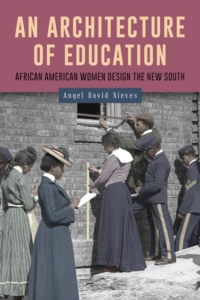 An examination of material culture and the act of institution creation, especially through architecture and landscape, to recount a deeper history of the lives of African American women in the post-Civil War South.
An examination of material culture and the act of institution creation, especially through architecture and landscape, to recount a deeper history of the lives of African American women in the post-Civil War South.
This volume focuses broadly on the history of the social welfare reform work of nineteenth-century African American women who founded industrial and normal schools in the American South. Through their work in architecture and education, these women helped to memorialize the trauma and struggle of black Americans. Author Angel David Nieves tells the story of women such as Elizabeth Evelyn Wright (1872-1906), founder of the Voorhees Industrial School (now Voorhees College) in Denmark, South Carolina, in 1897, who not only promoted a program of race uplift through industrial education but also engaged with many of the pioneering African American architects of the period to design a school and surrounding community. Similarly, Jane (Jennie) Serepta Dean (1848-1913), a former slave, networked with elite Northern white designers to found the Manassas Industrial School in Manassas, Virginia, in 1892.
An Architecture of Education examines the work of these women educators and reformers as a form of nascent nation-building, noting the ways in which the social and political ideology of race uplift and gendered agency that they embodied was inscribed on the built environment through the design and construction of these model schools. In uncovering these women’s role in the shaping of African American public spheres in the post-Reconstruction South, the book makes an important contribution to the history of African Americans’ long struggle for equality and civil rights in the United States.
Angel David Nieves is Associate Professor of History and Digital Humanities at San Diego State University. (more)
With New Urgency, Museums Cultivate Curators of Color

A growing number of people of color in New York City’s curatorial world include, from left, Rujeko Hockley, Marcela Guerrero, Adrienne Edwards, and Christopher Y. Lew of the Whitney Museum of American Art. (Credit: Bryan Derballa for The New York Times By Robin Pogrebin)
Growing up in the Brownsville section of Brooklyn, Akili Tommasino used to cut class to visit artworks like the ancient Egyptian “Head From a Female Sphinx” with gaping eye sockets at the Brooklyn Museum, or Umberto Boccioni’s striding bronze figure, “Unique Forms of Continuity in Space,” at the Museum of Modern Art.
Wandering through the galleries, Mr. Tommasino also couldn’t help noticing that the only people of color he saw were the security guards; it wasn’t until he later studied art history at Harvard that he realized African-Americans like himself could also be curators or even museum directors.
For decades the country’s mainstream art museums have excluded people of color — from their top leadership to the curators who create shows to the artists they display on their walls.
Now, eager to attract a broader cross-section of visitors at a time when the country’s demographics are changing — and, in New York, facing an ultimatum linking city funding to inclusion plans — a growing number of museums are addressing diversity with new urgency. (more)
TIPHC Bookshelf
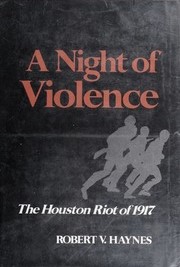 Published scholarship on black history in Texas is growing and we’d like to share with you some suggested readings, both current and past, from some of the preeminent history scholars in Texas and beyond. We invite you to take a look at our bookshelf page – including a featured selection – and check back as the list grows. A different selection will be featured each week. We welcome suggestions and reviews. This week, we offer, “A Night of Violence,” by Robert V. Haynes.
Published scholarship on black history in Texas is growing and we’d like to share with you some suggested readings, both current and past, from some of the preeminent history scholars in Texas and beyond. We invite you to take a look at our bookshelf page – including a featured selection – and check back as the list grows. A different selection will be featured each week. We welcome suggestions and reviews. This week, we offer, “A Night of Violence,” by Robert V. Haynes.
Haynes analyzes the factors involved in the 1917 riot resulting from the armed march on Houston by black soldiers of the 24th Infantry in retaliation for a white policeman’s assault on one of their noncommissioned officers.
The Houston Riot of 1917, also known as the Camp Logan Mutiny, involved 156 soldiers of the all-black 3rd Battalion, 24th Infantry – a unit of the famed Buffalo Soldiers. The incident occurred on August 23, 1917, lasting roughly two hours on a hot, rainy night, and resulted in the deaths of four soldiers and 15 white civilians. The episode has the ignominious distinction of being the only race riot in U.S. history where more whites then blacks were killed, and it also resulted in both the largest murder trial and the largest court-martial in U.S. history.
Almost four months later, on December 11, 13 black soldiers were summarily hung at a hastily constructed gallows near a shallow creek on Camp Travis, a National Guard training facility next to Fort Sam Houston in San Antonio. The men were unceremoniously buried nearby in graves whose only identification was a number, 1 through 13. Sixty-three other soldiers were given life sentences, and in September 1918 six more soldiers were hung at the same Camp Travis site.
This Week in Texas Black History
Aug. 19
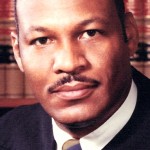 Andrew L. Jefferson, the first black state district judge in Harris County, was born on this day in 1934, in Dallas. Jefferson grew up in Houston, graduating from Jack Yates High School in 1936 and Texas Southern University in 1956. He graduated from the University of Texas School of Law in 1959 as the only African American to graduate in his class. As a statesman, Jefferson was active in numerous legal, civil and political organizations, holding the highest leadership offices for the American Bar Association, the State Bar of Texas, and the Houston Lawyers Association. He was admitted to practice law in all courts in the state of Texas as well as the United States district courts for the Southern and Western Districts of Texas, the United States Court of Appeals for the Fifth, Sixth, and Eleventh Circuit, and the United States Supreme Court. In 2001, the Andrew L. Jefferson Endowment for Trial Advocacy was established at Texas Southern University’s Thurgood Marshall School of Law. (Listen to Judge Jefferson’s oral history interview for the Houston Public Library here.)
Andrew L. Jefferson, the first black state district judge in Harris County, was born on this day in 1934, in Dallas. Jefferson grew up in Houston, graduating from Jack Yates High School in 1936 and Texas Southern University in 1956. He graduated from the University of Texas School of Law in 1959 as the only African American to graduate in his class. As a statesman, Jefferson was active in numerous legal, civil and political organizations, holding the highest leadership offices for the American Bar Association, the State Bar of Texas, and the Houston Lawyers Association. He was admitted to practice law in all courts in the state of Texas as well as the United States district courts for the Southern and Western Districts of Texas, the United States Court of Appeals for the Fifth, Sixth, and Eleventh Circuit, and the United States Supreme Court. In 2001, the Andrew L. Jefferson Endowment for Trial Advocacy was established at Texas Southern University’s Thurgood Marshall School of Law. (Listen to Judge Jefferson’s oral history interview for the Houston Public Library here.)
Aug. 23
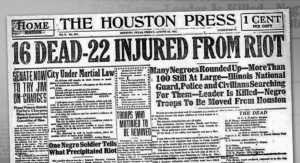 Members of the Third Battalion of the 24th Infantry (Buffalo Soldiers) were involved in the Houston Riots on this day in 1917. Also known as the “Camp Logan Mutiny,” men from the all-black unit violently marched on the city of Houston in response to racist treatment from the city’s white citizens and especially the persistent verbal and physical abuse from Houston policemen. As a result of the two-hour incident, which became known as the only “race riot” in U.S. history in which more whites (15) than blacks (4) were killed, 19 black soldiers were court-martialled and hung. It was the largest court-martial in military history and the largest murder trial in U.S. history.
Members of the Third Battalion of the 24th Infantry (Buffalo Soldiers) were involved in the Houston Riots on this day in 1917. Also known as the “Camp Logan Mutiny,” men from the all-black unit violently marched on the city of Houston in response to racist treatment from the city’s white citizens and especially the persistent verbal and physical abuse from Houston policemen. As a result of the two-hour incident, which became known as the only “race riot” in U.S. history in which more whites (15) than blacks (4) were killed, 19 black soldiers were court-martialled and hung. It was the largest court-martial in military history and the largest murder trial in U.S. history.
Aug. 24
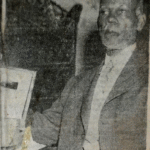 In 1859, Rufus F. Hardin, educator, was born into slavery in Kaufman County, southeast of Dallas. However, he was driven to become educated and did so, attending several black colleges and earning a degree at Prairie View Normal College. He taught in Brownwood for 38 years, beginning in 1896 at the Brownwood Colored School, the county’s only school for black children. Hardin also became a community leader. In 1934, the school was renamed in his honor.
In 1859, Rufus F. Hardin, educator, was born into slavery in Kaufman County, southeast of Dallas. However, he was driven to become educated and did so, attending several black colleges and earning a degree at Prairie View Normal College. He taught in Brownwood for 38 years, beginning in 1896 at the Brownwood Colored School, the county’s only school for black children. Hardin also became a community leader. In 1934, the school was renamed in his honor.
Aug. 25
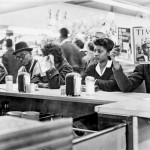 On this date in 1960, seventy Houston lunch counters quietly integrated, the result of an agreement between local businesses to avoid the unrest that had occurred in other U.S. cities during the civil rights movement’s lunch counter sit-in demonstrations. Bob Dundas, vice president of Foley’s department store in downtown Houston, got local downtown merchants to agree to desegregate their lunch counters all simultaneously on the condition that there would be no press coverage of the event. Dundas and John T. Jones, publisher of the Houston Chronicle and president of the Houston Endowment, secured an agreement between local newspapers and radio stations to remain silent on the event for ten days drawing criticism from the national press for censoring the move. Students from Texas Southern University had begun the sit-in movement in Houston in the spring of 1960. (See video, Texas Southern University: Silencing Houston’s Jim Crow; documentary,The Strange Demise of Jim Crow.)
On this date in 1960, seventy Houston lunch counters quietly integrated, the result of an agreement between local businesses to avoid the unrest that had occurred in other U.S. cities during the civil rights movement’s lunch counter sit-in demonstrations. Bob Dundas, vice president of Foley’s department store in downtown Houston, got local downtown merchants to agree to desegregate their lunch counters all simultaneously on the condition that there would be no press coverage of the event. Dundas and John T. Jones, publisher of the Houston Chronicle and president of the Houston Endowment, secured an agreement between local newspapers and radio stations to remain silent on the event for ten days drawing criticism from the national press for censoring the move. Students from Texas Southern University had begun the sit-in movement in Houston in the spring of 1960. (See video, Texas Southern University: Silencing Houston’s Jim Crow; documentary,The Strange Demise of Jim Crow.)
Aug. 25
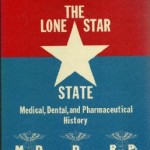 The Lone Star State Medical, Dental, and Pharmaceutical Association was formed on this date in 1886 in Galveston. The group came to be because the Texas Medical Association refused admission to 15 African-American medical professionals, including physicians Monroe Alpheus Majors – the first black Texan to graduate from a medical school (Meharry, 1886) and Benjamin Jesse Covington, one of the founders of Houston Negro Hospital (now Riverside General Hospital). After endorsing the group in 1939, the TMA began admitting African-Americans in 1955. Lone Star was the second organization of black medical professionals formed in the U.S., following the Medico-Chirurgical Society of Washington D.C. founded in 1884 as the first African-American medical society.
The Lone Star State Medical, Dental, and Pharmaceutical Association was formed on this date in 1886 in Galveston. The group came to be because the Texas Medical Association refused admission to 15 African-American medical professionals, including physicians Monroe Alpheus Majors – the first black Texan to graduate from a medical school (Meharry, 1886) and Benjamin Jesse Covington, one of the founders of Houston Negro Hospital (now Riverside General Hospital). After endorsing the group in 1939, the TMA began admitting African-Americans in 1955. Lone Star was the second organization of black medical professionals formed in the U.S., following the Medico-Chirurgical Society of Washington D.C. founded in 1884 as the first African-American medical society.
Aug. 25
Henry Miller Morgan, a barber, was born in Tyler on this day in 1895. Texas began requiring licenses for barbers in the 1920s, but because of segregation there were no schools admitting African Americans. In 1933, Morgan opened the first college for black barbers. The school had only five chairs, but in less than two decades, he had opened branches of his barber college around the country, including Houston, Dallas, New York, Jackson, Mississippi, and Little Rock. At one time, the school reportedly was training a majority of the nation’s African-American barbers. Morgan went on to help found the Texas Association of Tonsorial Artists, a professional barber’s organization, as well as the Democratic Progressive Voters League, one of the oldest African American political organizations in the state. On June 21, 2005, the Texas State Senate honored Morgan with a resolution honoring his life and achievements.
Blog: Ron Goodwin, Ph.D., author, PVAMU history professor
Ron Goodwin is an assistant professor of history at Prairie View A&M University. Even though he was a military “brat,” he still considers San Antonio home. Like his father and brother, Ron joined the U.S. Air Force and while enlisted received his undergraduate degree from Texas Lutheran University in Seguin, Texas. After his honorable discharge, he completed graduate degrees from Texas Southern University. Goodwin’s book, Blacks in Houston, is a pictorial history of Houston’s black community. His most recent book, Remembering the Days of Sorrow, examines the institution of slavery in Texas from the perspective of the New Deal’s Slave Narratives.
Recent Posts
Democratic Party – Fifty Years Later
In 1968, the Democratic Party met in Chicago to nominate its candidate for president. The Party was in chaos after the violent deaths of Robert Kennedy and Martin Luther King, Jr. While King was not an acknowledged political figure, his non-violent social stance and his views on American involvement in Vietnam was influencing public policies. Perhaps more influential in the forthcoming implosion of the Democratic Party was the death of Robert Kennedy. His politics of
Television — Fifty Years Later
Social pundits often consider 1968 a pivotal year in our democracy. Fifty years later, the deaths of Martin Luther King, Jr. and Robert F. Kennedy have many liberals questioning how compassionate our democracy may have been had they lived. There is no doubt they would have made a powerful one-two punch in eradicating many of the social ills caused by uncontrolled capitalism. Fifty years later we are also dealing with the implosion of the Democratic
Submissions wanted
Historians, scholars, students, lend us your…writings. Help us produce the most comprehensive documentation ever undertaken for the African American experience in Texas. We encourage you to contribute items about people, places, events, issues, politics/legislation, sports, entertainment, religion, etc., as general entries or essays. Our documentation is wide-ranging and diverse, and you may research and write about the subject of your interest or, to start, please consult our list of suggested biographical entries and see submission guidelines. However, all topics must be approved by TIPHC editors before beginning your research/writing.
We welcome your questions or comments. Please contact Michael Hurd, Director of TIPHC, at mdhurd@pvamu.edu.
